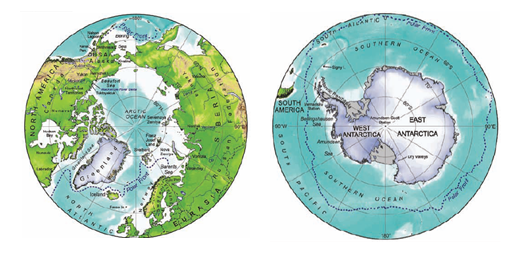1.2 The Polar regions
The polar regions are the extensive icy regions around the North and South Poles. In the north they are within an area called the Arctic Circle and in the south they are within an area called the Antarctic Convergence (see fig 2).

Figure 2. The left map shows the Arctic region that covers the area within the Arctic Circle, whilst the right map shows the southern polar region of Antarctica that covers the area within the Antarctic Convergence, including the Antarctic continent, the Southern Ocean and the sub-Antarctic islands. (IPCC 1997)
The polar regions are the coldest areas of the planet but the Arctic and Antarctica are quite different in character. While the majority of the Arctic region is ocean surrounded by landmasses, Antarctica is a frozen continent surrounded by ocean (IPCC 1997). The climate system is also quite different in both regions; Antarctica’s climate is generally much colder and oceanic while the Arctic’s climate is continental/sub-alpine. (WWF 2007a). Both the Arctic and Antarctic sea ice naturally partially melts and regrows in an annual cycle with sea ice reaching its maximum extent at the end of its winter cooling period after which it gradually shrinks back in response to the seasonally warmer environmental conditions.
The Arctic region includes the northern parts of Canada, Finland, Norway, Russia, Sweden, the United States (Alaska), and the whole of Greenland and Iceland. The ecosystems are varied, from the permanent ice cover on the more northern areas to taiga and boreal forest in the southern parts of the region. Tundra is the more extensive ecosystem but other ecosystems such as alpine and high mountain areas, broad-leaved forest in coastal areas, valleys and marshes also occur. (UNEP 1997). The Arctic supports many mammals and has an important role in the annual cycle of migratory birds. (CBD 2007). It also supports a large and diverse fish population.
Largely unchanged for the last 15 million years, Antarctica is the driest, coldest and windiest continent (NERC-BAS 2007b). The average annual temperature is –55°C (with -87°C being recorded at the Russian Vostic station) and wind speeds have been recorded to reach 250km per hour. 97.7% of the continent of Antarctica is covered by permanent ice, covering a total surface area of almost 14 million square kilometres (8,699,196 miles). This ice is distributed in two major ice sheets, the East Antarctic and the West Antarctic, and over ice shelves, extending over the sea water. (UNEP/GRID-Arendal 2003). The great thickness of the ice sheets (up to 2146m) makes Antarctica the world’s highest continent. Only a small number of species can contend with Antarctica’s harsh terrestrial conditions with only the Marieland Tundra (which is free of permanent ice) having a relatively high biodiversity and biomass. (UNEP/GRID-Arendal 2008). However, the seas surrounding Antarctica are rich in plankton, which supports a rich and diverse marine food web. (CBD 2007).